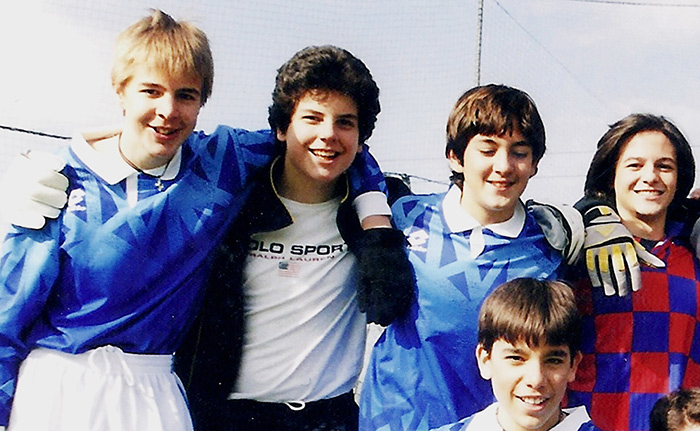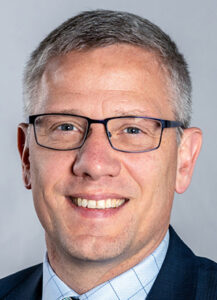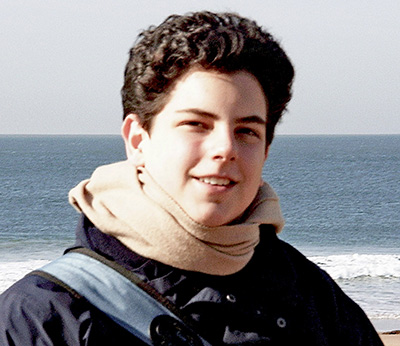
Carlo Acutis, second from left, hangs out with friends in this file photo.
By Barb Arland-Fye
The Catholic Messenger

Jerome Richter nearly dropped to his knees in Assisi, Italy when he realized that the 150 Catholic high school seniors he was leading on pilgrimage were born the same year that Blessed Carlo Acutis died: 2006. The canonization of Blessed Carlo, the first millennial saint, whose deep love for the Eucharist inspired him to use the internet to draw his peers and others back to church, was scheduled for April 27. However, it has been postponed due to the death of Pope Francis on April 21.

Referring to the youths that he led on the pilgrimage last summer, Richter told The Catholic Messenger, “This is the generation passing on the torch from Carlo.” Richter, the executive vice president and chief of staff at the University of Mary in Bismarck, North Dakota, imagines Blessed Carlo encouraging the youths to take up his mission: “I gave my life to the faith. You were born right as I was dying.”
The teens from North Dakota’s four Catholic high schools viewed Carlo’s body in his tomb in Assisi. Their reactions are palpable in the new documentary, “Carlo Acutis: Roadmap to Reality,” which explores the life of an ordinary teenager with an extraordinary faith who used technology to foster genuine spiritual communion rooted in Christ. It is a production of Castletown Media and Jim Wahlberg in association with the National Eucharistic Congress Inc., and the McGrath Institute for Church Life, University of Notre Dame.
The North Dakota teens’ pilgrimage became an integral part of the documentary, Tim Moriarty, its writer, director and producer, told The Messenger. “We had a lot of material and were already working on Carlo’s biography. We needed to give flesh to the story. We didn’t want it to be just didactic. We wanted it to feel like an experience. We knew something was missing.”
Moriarty contacted Richter, with whom he had previously worked on a video project, seeking to connect with University of Mary’s president Msgr. James Patrick Shea, who had “written beautifully about the Eucharist,” Moriarty said.
During their conversation, Richter told Moriarty that in two weeks, “I’m taking a group of 150 high school students to Rome and Assisi and one of the requirements is that they cannot take technology with them.” For Tim and his team, “It was an answer to prayer.” Following a virtual meeting between Richter and the documentary team, Christian Surtz, the co-director, headed to North Dakota where he interviewed and filmed the young pilgrims two days prior to their pilgrimage. Then he spent the next two weeks with them in Rome and Assisi. He followed up with interviews three months after the pilgrimage.
“You can imagine what happens when you take cell phones away from young people … they hear the voice of God in the quiet and they engage in the art of conversation,” Richter said. “They discover a new level of friendship and community that they never had before because of the distraction of technology.”
Moriarty said Blessed Carlo’s love for technology was well known but he also had the ability to set limits on his own consumption of the internet because he knew it could become addictive. He wanted to encourage kids his age to focus on their relationship with Jesus. Blessed Carlo had a deep, mystical faith, his mother, Antonia Salzano Acutis told Moriarty. “That started us on a journey about what Carlo is saying in a digital age,” Moriarty said. “There’s a way in which this virtual world, which feels exciting, is oftentimes orchestrated. It is making us blind to reality.”

Blessed Carlo created a website featuring eucharistic miracles, hoping to inspire his peers and others to embrace the Catholic faith, and he did. “His goal was to get people off of his website and back into the Church,” evangelist Chris Stefanick says in the documentary. “He realized it as an instrument that had fantastic power, if used well for evangelization,” Carlo’s mother says.
“The film is about Carlo but it’s much more about how Carlo is a model for how to navigate the digital world we’re in and how to remain connected to reality,” Moriarty said. “One of the things we explore in this (documentary) is that if screen time and the digital world are in a way ordered to distract us … our attention is healed in quiet time, in prayer.” Carlo’s discipline in setting limits for himself “came from the true joy of the presence of Jesus.”
Richter, who began leading the annual pilgrimage to Rome for Catholic high school students in 2001, said his mission then and now is for students to experience the Eternal City with their own eyes and hearts. Last year’s pilgrims had the added benefit of learning about Blessed Carlo and seeing his tomb where he appears as if resting, wearing typical clothes for a teen in 2006. “This is a saint they can very much relate to,” Richter said. One of the students burst into tears, telling Richter that her best friend was wearing the same shoes that Blessed Carlo was wearing.
Bishop Dennis Walsh says that in his confirmation homilies, he tells confirmandi that God calls them to greatness, to be saints. He uses Carlo Acutis as an example “because he is someone who was very ordinary. He didn’t live hundreds of years ago. He lived in our lifetime. His mother and father are still living. He had the same passions as our young people today, i.e. soccer, computer games, sports, etc. He was just an ordinary teenager and yet in his heart he was consumed by a love for Jesus Christ. He is a great witness for youth today.”
To purchase tickets
To find a movie theater showing “Carlo Acutis: Roadmap to Reality” go to (carloacutisfilm.com/buy-ticket). Show dates are April 27-29, 2025 in select theaters.








